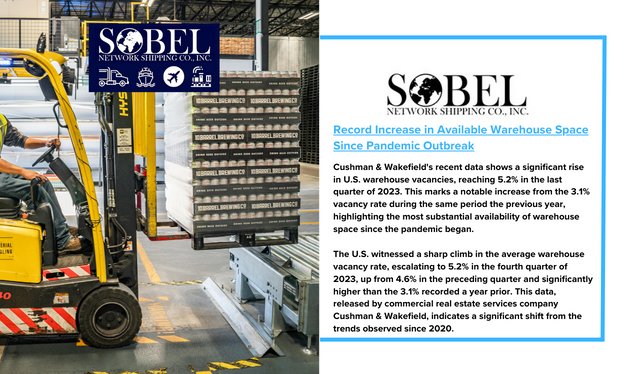Cushman & Wakefield’s recent data shows a significant rise in U.S. warehouse vacancies, reaching 5.2% in the last quarter of 2023. This marks a notable increase from the 3.1% vacancy rate during the same period the previous year, highlighting the most substantial availability of warehouse space since the pandemic began.
The U.S. witnessed a sharp climb in the average warehouse vacancy rate, escalating to 5.2% in the fourth quarter of 2023, up from 4.6% in the preceding quarter and significantly higher than the 3.1% recorded a year prior. This data, released by commercial real estate services company Cushman & Wakefield, indicates a significant shift from the trends observed since 2020.
In 2020, the onset of the pandemic and a boom in e-commerce sales triggered an unprecedented demand for warehousing, leading to extensive construction and leasing activities in this sector. Companies, including e-commerce giant Amazon.com, rapidly expanded their storage facilities to meet the burgeoning demand for home deliveries. This expansion drive brought the national vacancy rate down to as low as 3% by late 2022, with areas like Southern California reaching full capacity.
Over the past four years, developers have added more than two billion square feet of storage and distribution space, responding to the then-vibrant market conditions. However, the last 18 months have seen a shift, with retailers scaling back on restocking inventories and postponing leasing decisions, influenced by rising interest rates, changing consumer spending habits, and economic uncertainties in the U.S.
The total new warehouse space leased in 2023 was approximately 588 million square feet, a 27% decrease from the previous year, as reported by Cushman & Wakefield. Despite a continued expansion in warehouse capacity, as indicated by the Logistics Managers’ Index in December, the pace of growth has decelerated compared to November.
Developers are now adjusting their building plans to align with the reduced demand. Yet, the fourth quarter of 2023 saw the completion of over 156 million square feet of new warehouse space, marking the second-largest quarterly total for construction completions, as many projects reached completion.
Jason Price, head of logistics and industrial research at Cushman & Wakefield, notes that although new development has outpaced demand, there are evident signs of construction slowdown in response to market dynamics and moderated absorption rates.
Despite the recent increase, warehouse space availability is still relatively low compared to historical standards. The 5.2% vacancy rate in the fourth quarter is only slightly higher than the 4.7% rate at the end of 2019, pre-pandemic, and remains below the 15-year average of 6.4%.
Rental demand continues to be strong enough to drive up rents. The average asking price for industrial space rose by 10% year-over-year in the fourth quarter, reaching $9.79 per square foot.
Strong demand persists in major industrial regions like Houston, eastern Pennsylvania, and Southern California. However, Cushman & Wakefield has not released detailed regional market data in its initial analysis of the last quarter of the year.
Industry experts caution that the slowdown in leasing activity could lead to an oversupply of warehouse space in the near future, especially with several million square feet of new development still underway, much of it speculative and without pre-secured tenants.


